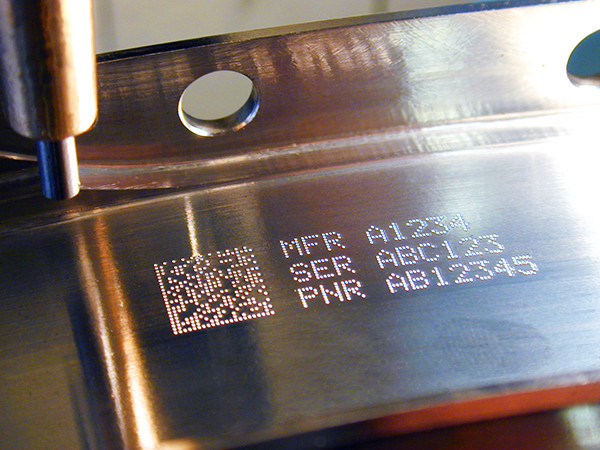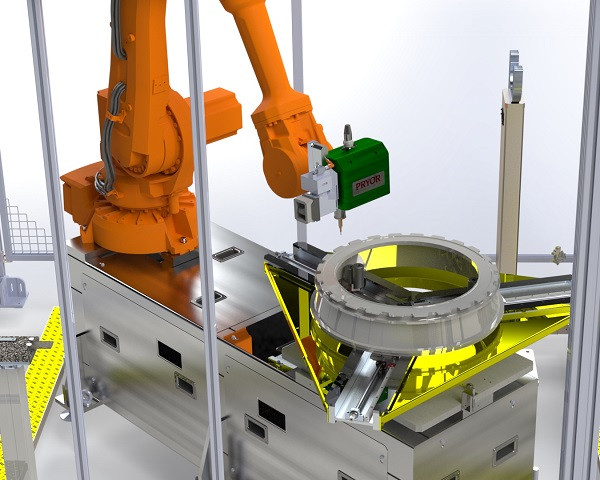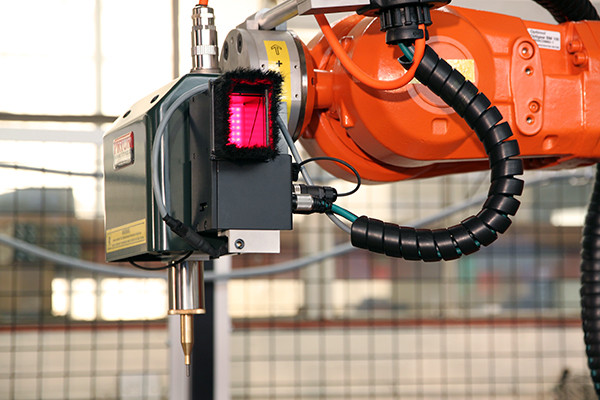Dan Stephenson at Pryor explains how robotic systems help to meet aero industry specifications for marking aerospace components.
Aero industry specifications insist that parts like engine components are permanently marked, to give each one a unique identification. Despite the importance of the process, marking adds no value to a part. It also has no functional effect, because it has no effect on performance. However, the process is critical to the smooth running of the aerospace industry. The markings applied to a part during production allow it to be tracked, assembled, replaced, and correctly maintained and positioned.
Historically – and, in some cases, to this day – parts have been marked manually. Some short-run parts, which are not highly expensive, can be handled adequately using hand-held marking devices, for instance. However, for large, expensive parts – which may require multiple marks to be made, in precise locations – a more modern technique such as robotic control is required.
Aero engine components can be astronomically expensive, with some individual parts worth upwards of £100,000. The last thing anybody wants is for it to be rendered worthless by a poorly applied or positioned mark.

Marking is critical in the aerospace industry and in many cases mandatory. Aero industry specifications – such as the UID standards laid down by the US Department of Defence, or SAE International’s AS9132 marking standard – insist that parts are permanently marked in order to give them a unique identity.
This is done by applying readable information and a Data Matrix code (similar to a barcode) onto the surface.
The unique ID is a ‘passport’ for the part which provides a link to all kinds of information on its manufacture – including details such as where the material came from, and which operator was running the machine when it was made. This allows precise traceability, such as in the case of part failure.
On top of this, individual manufacturers have their own additional specifications on marking which include details of how the mark should be applied, formatted and positioned, as well as adding critical engineering details, and specific details on how parts are put together in the engine.
Pryor’s multi-axis robotic marking systems are generally used on round and cylindrical aero engine components, including disks, rings, blades and blisks (‘bladed disks’).

Although the robotic arm can incorporate any type of marking system, the aerospace industry typically uses dot peening to create permanent marks on metal components. Pryor’s system works with parts up to 1.2m in diameter though could handle larger if required.
When Pryor first introduced robotic control to aero components, it was dealing with relatively small parts. For this reason, it grasped the component itself, and moved it to a stationary marking head. Now, as it has dealt with much larger parts – such as blisks – the robotic control has shifted to the marking head itself. This improves accuracy and allows multiple marks to be made – to very tight tolerances – across the surface of the part.
In a typical scenario, a large part is moved into a ‘marking cell’, loaded onto a rotary table and clamped into place. An operator scans the part’s unique ID, which calls up a programme with marking instructions. These are carried out by the robot-mounted marking head. The whole process is controlled by Pryor’s software, which is linked to the manufacturer’s plant manufacturing system to ensure the correct data is applied.
A large, expensive part like a blisk, may require 15 or more marks to be made at various points, with position tolerances of 0.1mm. On top of this, a typical aero engine will have hundreds of parts that need to be marked in this way. Doing this manually would be impossible.
A key element is Pryor’s vision system, which helps to validate and verify all marks. It checks that the marked information is correct and that it meets the relevant specification.
However, it can also help to ensure that the original positioning of the mark is correct. While this information will be loaded as part of the marking programme, a mark may have to be made relative to a certain feature of a component. The camera can find this feature and apply an offset to the marking program as a further check to ensure correct mark placement

At the Paris Air Show, Pryor will demonstrate a version of the company’s Aerospace Rotatives Marking Cell. The system will use an ABB robot, in combination with a roatary table and a full marking head and vision system, to mark a series of cylindrical parts.
It will be a good representation of the system that would be installed by manufacturers of these parts. It will not simply run in the background as a feature of the stand however, if any visitors are interested in finding out more about the verification process, Pryor will stop the demo and talk them through it.
Pryor has found that customers often find a business case for purchasing such a system by using it to mark a wide range of parts (including many smaller ones, that might usually be done manually). Overall, they have found they can mark parts more efficiently – and ensure better traceability – by using ‘idle time’ on these smaller components.
Aero engines are larger and more complex than ever and this is only going to increase. As large parts like blisks become more commonplace and engine designs evolve to become more efficient, the need to track and assemble individual components will continue to grow in importance.
Whilst it technically has no value, robotic marking is an essential part of traceability in aerospace, in that it allows each individual component to be marked correctly and to specification at the first attempt, making the manufacturing process much more efficient. The cost of marking components incorrectly can be much greater than investing in a reliable system.
Find out more about aerospace marking standards:
Find out more about 53rd International Paris Air Show here

